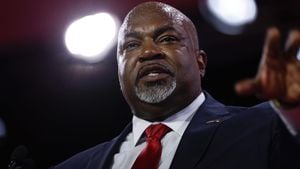A recent twist of fate has put two NASA astronauts, Butch Wilmore and Suni Williams, on what's unexpectedly turning out to be a long-term stay aboard the International Space Station (ISS). Initially, the plan was to keep the astronauts there for only about a week, which began on June 6, but as of August 12, the prospects have changed drastically due to significant technical issues with Boeing's Starliner spacecraft, which they were scheduled to return on.
The clock is ticking, and as the launch window for their return remains uncertain, NASA is now considering alternative options to bring them home. With the possibility of their stay extending until February, decision-makers at NASA are racing against time. "If the problems cannot be resolved soon, we may rely on SpaceX's Crew Dragon for their return," said officials during recent discussions about the situation.
This situation stems from various technical glitches related to the Boeing Starliner spacecraft’s operations. Key issues include helium leaks and problems with the thrusters—both critical for safely returning astronauts to Earth. A particularly troubling factor has arisen surrounding the design of the seals within the propulsion system, which could be contributing to the difficulties. The investigations around these problems are still underway, as both NASA and Boeing are working hand-in-hand to find effective solutions. Boeing asserts they can tackle these issues, emphasizing their commitment to rectify the Starliner spacecraft swiftly.
NASA's assigned astronauts have already spent over two months aboard the ISS, which is significantly longer than initially intended. "We’re just exploring our options at this point," NASA's spokesperson confirmed, indicating the agency's serious consideration of SpaceX’s Crew Dragon capsule, which has displayed reliability on multiple previous missions.
Should NASA decide to utilize SpaceX’s vehicle for the return, scheduled to happen sometime between late September and February, Wilmore and Williams would be preparing for the launch of the Crew-9 mission. An interesting detail is how this would also mean two seats would remain empty on the Crew Dragon, which typically accommodates four passengers.
The decision whether to continue pushing for the damaged Starliner or pivot to SpaceX is expected to be made as mid-August approaches. NASA officials are putting their best efforts forth, stressing they have not made any solid decisions yet. Ken Bowersox, NASA’s associate administrator for Space Operations, mentioned their priority is still to return the astronauts on Boeing's Starliner. "We want to resolve these technical issues and get everything back on track. Returning with Starliner remains the prime option," he noted. Although it appears promising, NASA must weigh the risks involved when pushing to fix Starliner against the need to safeguard the astronauts' well-being.
The problems surrounding Boeing’s Starliner program aren't novel. Historically, Boeing has had its share of challenges, with delays plagued by software bugs and technical failures. For example, there was the embarrassing software issue during the Starliner's first uncrewed test, which resulted in the capsule straying off course. This raised concerns about the overall reliability of the spacecraft. The company has since been dealing with fallout from these setbacks, all the more challenging as it competes with SpaceX, which has been smoothly operating its Crew Dragon with great success since its first crewed mission in 2020.
Boeing is under scrutiny not only for this mission but for its overall operational safety, especially considering the company’s recent troubles with its commercial jetliners. The intense spotlight on Boeing is amplified by this current situation with NASA, and if Wilmore and Williams are sent home on SpaceX’s Crew Dragon, it could be viewed as another major blow to Boeing's standing as a leading provider of spacecraft technology.
Steve Stich, who manages NASA's Commercial Crew Program, shared insights during briefings about the need for thorough analysis. “We want to understand the root of the problems,” he said, showcasing the need for investigative diligence. When Starliner made its ascent to the ISS, serious propulsion issues came to light, generating concern across the aerospace community.
The current situation is undoubtedly complex, with need for immediate action threading through every discussion. The collaboration between NASA and Boeing looks promising, but one question lingers: can they find the answers soon enough? With impatience among all parties involved growing, the need for resolution not only affects the astronauts but also invovles thousands of workers behind the scenes diligently supporting the mission. Accumulating signals indicating delays have fueled frustration, as the astronauts’ extended duration speaks to broader systemic hurdles present within Boeing’s approach to this project.
With rising uncertainties, options involving SpaceX appear even more feasible. NASA successfully completed several missions with Crew Dragon, underscoring its reliability and speed across multiple workstreams. Observers familiar with the evolving drama play out might wonder: will Boeing’s star be overshadowed by the swift efficacy of SpaceX as the agency PM on their astronauts returning home? Time seems to be the answer, but what is certain for now is the need for swift coordination between NASA, Boeing, and its backup plan surrounding SpaceX.
NASA has not set timelines solely based on the practical aspect of technical fixes—additional measures are still being taken behind-the-scenes to clear outdated expectations surrounding incoming missions. There’s talk of another launch delay within August, initially planned for this month, leading many to contemplate whether this extension will open the door for mission-prioritizing recognition.
Everyone is left on the edge of their seats, waiting to see what happens next. Will Boeing's Starliner find its way back to reliability and play its destined role, or will NASA lean on SpaceX? This intertwining narrative not only shapes the future of space travel but serves as another chapter written on the cartridge of human achievement within the cosmos.



